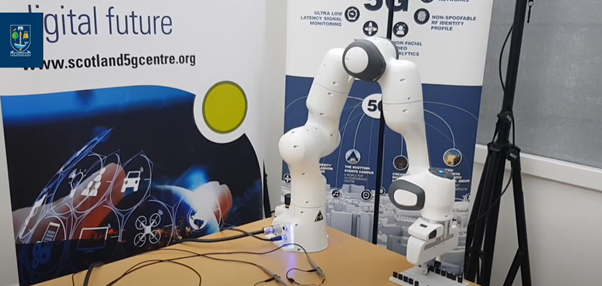The collaboration is part of the international partnership between the Glasgow University and the University of Electronic Science and Technology of China (UESTC) in Chengdu to deliver undergraduate degree programmes in China.
Students have the opportunity to remotely program a Panda robot arm located in the James Watt South building on Glasgow University's Gilmorehill campus. It has been made available for students on UESTC’s Circuit Analysis and Design course to use initially, with Glasgow students being given the chance to try the arm ahead of it being integrated into teaching in the near future.
Extend Robotics unveils new VR-controlled robotic arm
“It’s important that we try to give students as much of the experience of hands-on learning as we can, even during a pandemic where everyone is being advised to keep their hands to themselves as much as possible,” said one of the project leads, Dr Guodong Zhao, lecturer in Systems Power and Energy at Glasgow University.
“This pilot project is a step towards our goal of helping to realise ‘Education 4.0’ – integrating AI, robotics and other technology into the classroom. It opens up a lot of possibilities for teaching not just during this difficult time but also, once some normality is restored to everyday life, allowing students to complete practical work in the lab from anywhere in the world, at any time.”

Glasgow University researchers developed new software to allow students to book time with the robot and to operate it remotely to complete tasks they would normally do themselves in the lab. Developed by Franka Emika in Germany, the robot arm is designed to offer fine-grained control in a wide range of applications.
In this project, it is helping students build circuits as part of their coursework. Users can pre-program the path the robot will take to pick up parts, place them and connect them to complete circuits. The work will be graded by teaching staff the same way it would have been had the students been doing it in person, and the team is also investigating the possibility of making the arm fully user-controlled via webcam and integrating it into the university’s 5G testbed.
“The speed of digital communication that 5G provides is remarkable, and opens up many new possibilities for ‘telepresence’, with an almost instant connection between systems anywhere in the world,” said Professor Muhammad Imran, Professor of Communication Systems at the University and a Dean of Glasgow University's UESTC.
“That could mean that lecturers might not need to travel around the world in the future to give lectures. Instead, using direct control of robots with zero-lag connections, they could have a physical presence in the lab from the other side of the world.”




Glasgow trial explores AR cues for autonomous road safety
They've ploughed into a few vulnerable road users in the past. Making that less likely will make it spectacularly easy to stop the traffic for...